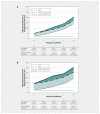Combined impacts of multimorbidity and mental disorders on frequent emergency department visits: a retrospective cohort study in Quebec, Canada
- PMID: 31266786
- PMCID: PMC6606417
- DOI: 10.1503/cmaj.181712
Combined impacts of multimorbidity and mental disorders on frequent emergency department visits: a retrospective cohort study in Quebec, Canada
Abstract
Background: Multimorbidity and mental disorders are independently associated with frequent visits to the emergency department (≥ 3 visits/yr), but their interaction has been little studied. We aimed to measure the interaction between mental disorders and physical multimorbidity with respect to frequent visits to the emergency department.
Methods: We conducted a population-based cohort study of adults in Quebec from 2012 to 2016, using the Quebec Integrated Chronic Disease Surveillance System. We assessed multimorbidity as the number of physical illnesses and mental disorders as serious (psychotic or bipolar disorders), common or absent, using data from 2012 to 2014. We counted emergency department visits from 2014 to 2015. We used logistic regression to estimate interaction on frequent visits to the emergency department from 2 perspectives: of public health (additive scale as differences in risk) and of individual patients (multiplicative scale as odds ratios).
Results: Each additional physical illness was associated with a greater increase in the absolute risk of frequent visits to the emergency department for people with mental disorders. Between 0 and ≥ 4 physical conditions, the absolute risk increased more for individuals with serious mental disorders (16.2%) than common (15.3%) or no disorders (11.4%). On the relative scale, for people with no mental disorders and ≥ 4 physical conditions, odds of frequent visits to the emergency department were 6.2 (95% confidence interval [CI] 6.08-6.35) times the odds for people with no physical conditions. For individuals with common and serious mental illnesses, corresponding odds ratios were 4.75 (95% CI 4.60-4.90) and 3.7 (95% CI 3.18-3.57), respectively.
Interpretation: Mental disorders interact with physical multimorbidity to increase the odds of frequent visits to the emergency department. More research is needed on interventions that promote high-quality care for mental illness, especially in the context of physical multimorbidity.
© 2019 Joule Inc. or its licensors.
Conflict of interest statement
Competing interests: Bernard Candas is an employee of the Institut national de santé et services sociaux du Québec. No other competing interests were declared.
Figures

Comment in
-
Bridging the mental-physical divide in health care.CMAJ. 2019 Jul 2;191(26):E722-E723. doi: 10.1503/cmaj.190709. CMAJ. 2019. PMID: 32392476 Free PMC article. No abstract available.
References
-
- Barnett K, Mercer SW, Norbury M, et al. Epidemiology of multimorbidity and implications for health care, research, and medical education: a cross-sectional study. Lancet 2012;380:37–43. - PubMed
-
- Boyd CM, Fortin M. Future of multimorbidity research: how should understanding of multimorbidity inform health system design? Public Health Rev 2010;32:451–74. 10.1007/BF03391611. - DOI
-
- Katon WJ. Clinical and health services relationships between major depression, depressive symptoms, and general medical illness. Biol Psychiatry 2003;54:216–26. - PubMed
-
- Parks J, Svendsen D, Singer P, et al., editors. Morbidity and mortality in people with serious mental illness. Alexandria (VA): National Association of State Mental Health Program Directors (NASMHPD) Medical Directors Council; 2006.
MeSH terms
LinkOut - more resources
Full Text Sources
Medical
